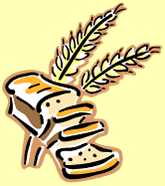This page has been archived and is being provided for reference purposes only. The page is no longer being updated, and therefore, links on the page may be invalid.
|
|
Scientists Developing Bread Rich in Beta-Glucan
By Jan SuszkiwNovember 30, 2007
Guests visiting the laboratory of Agricultural Research Service (ARS) chemist Abdellatif Mohamed might be surprised by the smell of fresh-baked bread, rather than chemicals.
The "nose knows," though, because that's exactly what Mohamed is doing—baking soft white bread that resembles any store-bought loaf, except for a key difference: its beta-glucan content. Research suggests that, when ingested, this soluble fiber helps the body regulate blood glucose and lower "bad" cholesterol, diminishing the risk of coronary heart disease.
The bread owes its 0.75 grams of beta-glucan per serving to C-TRIM, a barley- and oat-bran-based powder that Mohamed used in studies at the Cereal Products and Food Science Research Unit (CPFSRU), part of the ARS National Center for Agricultural Utilization Research in Peoria, Ill.
He began researching beta-glucan bread in late 2005, shortly after another CPFSRU researcher, chemist George Inglett, presented C-TRIM at an American Chemical Society meeting in Washington, DC. Inglett's ARS-patented product also cuts calories in food by mimicking the properties of fats and complex carbohydrates.
Together with Oklahoma State University professor Patricia Rayas-Duarte and CPFSRU physical scientist Jingyuan Xu, Mohamed experimented with two dough formulations containing flour from hard red spring wheat, gluten, 17 percent or 17.5 percent C-TRIM, and other breadmaking ingredients.
Adding C-TRIM didn't significantly change the bread's taste, texture or volume, Mohamed notes, although it did darken the bread slightly. Using such evaluations as baseline information, his team will conduct computer modeling studies to predict what changes are likely when, for example, up to nine grams of beta-glucan are added. Of particular interest is the biochemical interplay between starch and protein, which can affect bread's volume and shelf life.
At current C-TRIM levels, a consumer would have to eat four slices of C-TRIM bread per day—equal to three grams of beta-glucan—in order to reap the fiber's potential health benefits. But related applications of C-trim, including in yoghurt and chocolate-dipped pretzels, could easily make increased amounts of beta-glucan available to obtain those same benefits.
ARS is the U.S. Department of Agriculture's chief scientific research agency.

